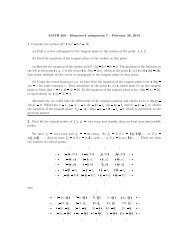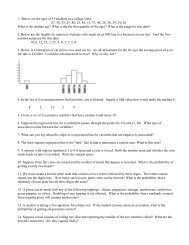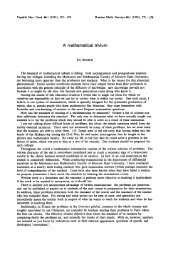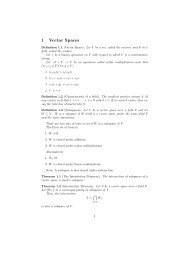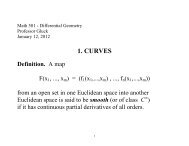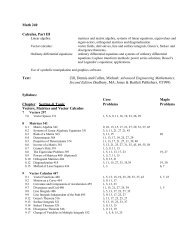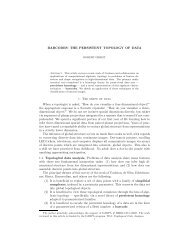MORSE THEORY AND THE GAUSS-BONNET FORMULA Alina ...
MORSE THEORY AND THE GAUSS-BONNET FORMULA Alina ...
MORSE THEORY AND THE GAUSS-BONNET FORMULA Alina ...
You also want an ePaper? Increase the reach of your titles
YUMPU automatically turns print PDFs into web optimized ePapers that Google loves.
Lemma 5.3. S0 = {p ∈ S N : dp is a Morse function } has full measure in S N .<br />
Proof. From [9] we know that x ∈ M is a degenerate critical point of dp for<br />
some p = expxw if and only if p is a focal point of M. Therefore, dp is a Morse<br />
function whenever p is not a focal point of M. But focal points are critical values of<br />
the normal exponential map (see [6]), which is a smooth map; therefore, by Sard’s<br />
theorem, the set of focal points of M has measure zero in S N . �<br />
The Morse index theorem for distance functions (see [9]) states that the index of<br />
x ∈ M as a nondegenerate critical point of dp is exactly the number of focal points of<br />
M with base x situated on the segment from x to p, counted with multiplicities. As<br />
focal points are critical points of F , we can conclude that for every point q = F (x, v)<br />
on the segment from x to p the index of dF(x,v) equals the number of focal points<br />
between q and x. The inverse image of the set of focal points thus divides ν π M into<br />
regions with indices that increase as we move further from M.<br />
In the following proof we essentially compute the volume of all these regions, with<br />
the corresponding indices. It might be possible to study the regions individually, as<br />
they contain information about the number of critical points of distance functions<br />
and, implicitly, about the topology of M.<br />
Proof of theorem 5.2. For any p ∈ S0, let Ck(p) be the set of critical points of<br />
20<br />
�



